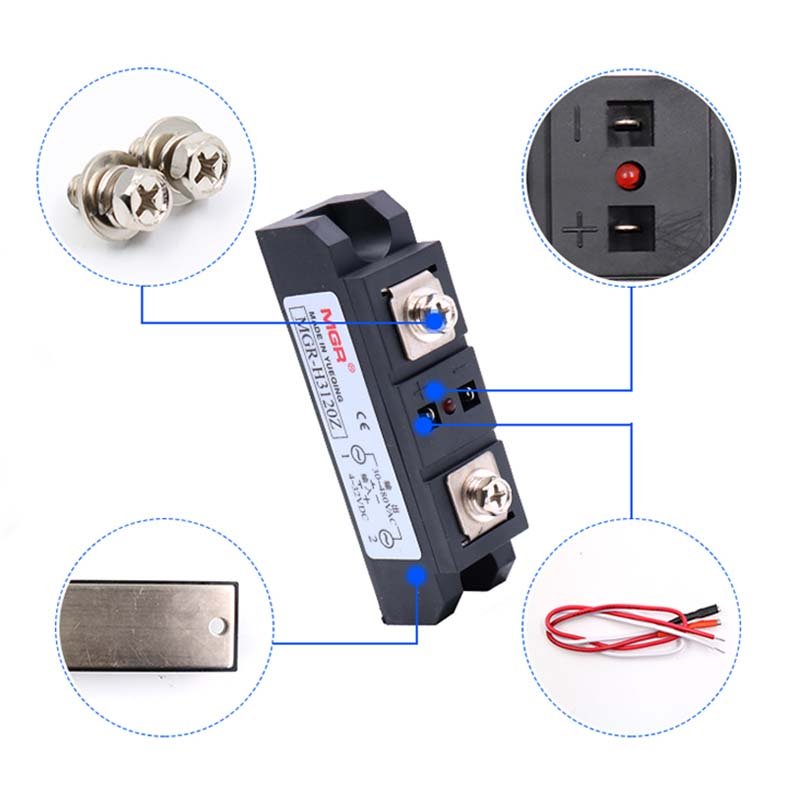1. Product core introduction
HomeDIYer presents the MGR-H3120Z Solid State Relay Module for 220V circuits with a current carrying capacity of up to 120A and a control voltage range of 4 - 32VDC. Designed to provide reliable and efficient switching for a wide range of industrial and high-power electrical systems, these MGR industrial grade solid state relays are designed to withstand harsh operating conditions and provide precise control for demanding applications such as motor control, heating systems, industrial automation, and more.
2. The main characteristics of the product
High Current Carrying Capacity: Rated current up to 120A, it can easily cope with the switching needs of high power loads, such as industrial grade motors, large heating equipment, welding machines, etc. In high power applications, it can stably and reliably control the on-off current to ensure normal operation of the equipment, avoiding problems such as heat generation, overload or even damage caused by insufficient relay capacity, providing solid switching protection for high power electrical systems and enhancing system stability and reliability.
Wide voltage control range: The control voltage range is 4 - 32VDC, which is compatible with a variety of common control signal sources, making it convenient for users to flexibly match the voltage output of the actual control system. Both low-voltage microcontroller output signals and transformed higher voltage control signals can effectively drive the relay to work and achieve precise control of the load, enhancing the applicability and versatility of the relay in different electrical control systems.
Industrial-grade quality and durability: Made of high-quality industrial-grade materials, it has excellent heat, cold and moisture resistance as well as vibration and shock resistance, and is able to operate stably for a long time in harsh industrial environments. The internal semiconductor components and circuit design are optimised for high reliability and long life, reducing the incidence of failures due to environmental factors, lowering maintenance costs and replacement frequency, and providing strong support for the continuity and stability of industrial production.
Fast switching response: Compared with traditional relays, it has extremely fast switching speed, and can complete the on and off of the circuit in an instant, with a response time usually at the millisecond level or even shorter. This makes it outstanding in applications requiring high switching speed, such as high-frequency motor control, fast heating systems, etc. It is able to achieve precise current control and fast system response, improve the efficiency and performance of the equipment, and meet the needs of modern industry for high-speed, high-precision control.
Advantage of contactless design: Adopting solid-state switching technology without mechanical contacts avoids the problems of arc, wear and tear, and poor contact caused by the opening and closing of contacts in traditional relays, thus significantly improving the service life and reliability of relays. At the same time, the contactless design also reduces the generation of electromagnetic interference, enabling the relay to work stably in electronic equipment and control systems that require high electromagnetic compatibility, improving the stability and reliability of the entire system and reducing the risk of system downtime due to relay failure.
3. Product use scene
Industrial motor control: In industrial production, it is used to control the start, stop and forward/reverse rotation of all kinds of motors, such as machine tool motors, conveyor belt motors, water pump motors, fan motors and so on. Its high current-carrying capacity and fast switching response characteristics can ensure stable operation of motors during frequent start-stop operations, accurately control the running status of motors, and improve production efficiency and equipment reliability. At the same time, the non-contact design reduces the electromagnetic interference during motor operation, which is conducive to the stable operation of the motor control system, prolongs the service life of the motor and related equipment, reduces the maintenance cost of the equipment, and ensures the continuity and stability of industrial production.
Heating system application: widely used in industrial heating equipment, such as electric heating furnace, heating cylinder of plastic extruder, heat treatment equipment, etc., as well as commercial and civil large-scale heating devices, such as electric boiler of central heating system, hot air oven of industrial plant. It can accurately control the current flow of the heating element and realise the precise adjustment of the heating temperature to meet the requirements of different processes and environments for temperature control. Its high current capacity ensures the stability and reliability of the heating system during high-power operation, and its fast switching response helps to quickly adjust the heating power, improve the efficiency of energy utilisation, reduce energy consumption and operating costs, and provide key support for the efficient and safe operation of the heating system.
Industrial automation production line: as a key execution element in the automation control system, it is used in the electrical control of various industrial automation equipment and production lines, such as automated assembly equipment, robot control systems, packaging machinery and so on. In these complex automation systems, MGR-H3120Z solid state relays can switch circuits quickly and accurately according to the instructions of the control system to achieve precise control of various actuators (such as cylinders, solenoid valves, motors, etc.), ensure efficient operation of the production line and the coordination of the processes, improve the degree of automation and production efficiency of industrial production, enhance the competitiveness of enterprises in the market, and is an indispensable part of modern industrial automation production. It is an indispensable and important part of modern industrial automation production.
4. Product use instructions
Preparation before installation:
Check the appearance of the relay module for defects such as breakage, deformation, bent pins or oxidation, etc. If there are any problems, contact the supplier for replacement in time to ensure that the quality of the MGR-H3120Z Solid State Relay used is intact and undamaged.
Determine the installation position of the relay according to the actual application scenario and the requirements of the control system, and prepare suitable installation tools, such as screwdrivers, spanners, pliers, heat sinks (if required), etc., to ensure the precision and applicability of the tools, so as to avoid damaging the relay in the installation process. At the same time, make sure that the installation environment is in line with the working conditions of the relay, avoiding high temperature, humidity, strong magnetic field and other unfavourable factors that may affect its performance.
Installation and Connection:
Mount the MGR-H3120Z Solid State Relay on a suitable heat sink (e.g. metal heat sink), ensuring close contact to effectively dissipate the heat generated during operation and ensure the normal operating temperature of the relay. Use screws to secure the relay to the heat sink, taking care not to over-tighten to avoid damaging the relay case.
According to the pin definition of the relay and the electrical connection requirements of the control system, use wires of suitable specifications to connect the control signal input (usually labelled ‘+’ and ‘-’, corresponding to 4 - 32VDC control voltage) to the control source, the load side (the pin connecting the 220V load pin) to the corresponding electrical equipment, pay attention to the correctness and firmness of the wiring to avoid problems such as connecting the wrong wire, false connection or short circuit. After the wiring is completed, check whether all the connection points are firm and reliable, make sure that the wires are not damaged and have good insulation to prevent failures caused by poor electrical connections.
Debugging and testing:
After completing the installation and wiring, perform a preliminary power-on test of the relay. Firstly, apply a suitable control voltage (in the range of 4 - 32VDC) and observe whether the relay responds properly, i.e. whether the circuit at the load side switches on and off according to the expected control signal. Electrical test instruments such as multimeters can be used to measure the voltage and current at the load side to check whether the relay switches normally.
Before actual application, it is also necessary to test the performance of the relay under different load conditions, especially under the condition of approaching or reaching its rated current of 120A, to observe whether the heat generation, switching stability and control accuracy of the relay to the load and other indicators meet the requirements. If the relay is found to have problems such as abnormal heating, unstable switching or inaccurate control, the wiring, heat dissipation device and load matching should be checked in time, and corresponding adjustments and optimisation should be carried out to ensure that the relay can operate reliably and stably in actual work.
Precautions for use:
Regularly check and maintain the relay to see if there is any abnormality in its appearance, such as heat, smoke, odour, discolouration of the shell and so on. At the same time, check whether the heat dissipation device is working properly, make sure that the contact between the heat sink and the relay is good, and that there is no accumulation of dust or debris to affect the heat dissipation effect. If it is found that the heat dissipation is poor or the relay shows signs of overheating, the heat sink should be cleaned up in time or other heat dissipation measures should be taken, such as increasing the fan heat dissipation, etc., in order to ensure that the relay operates within the normal operating temperature range and prolong its service life.
















